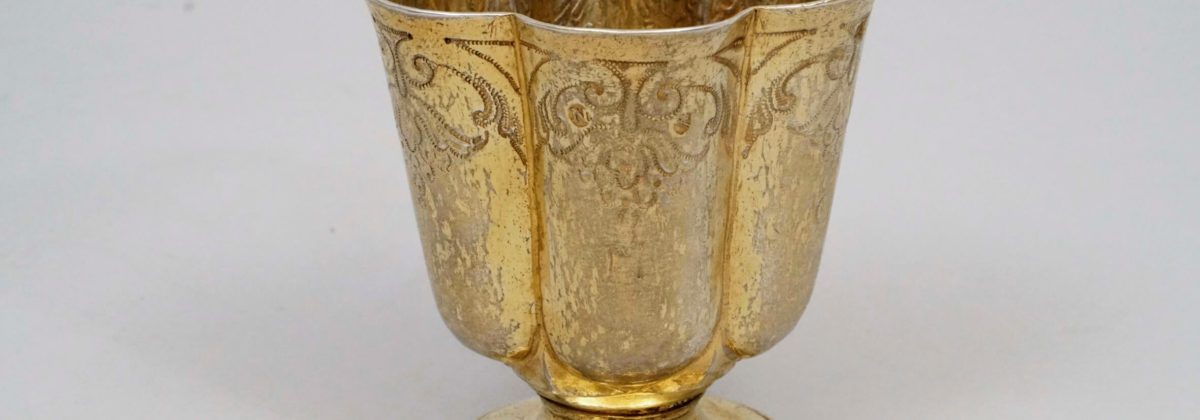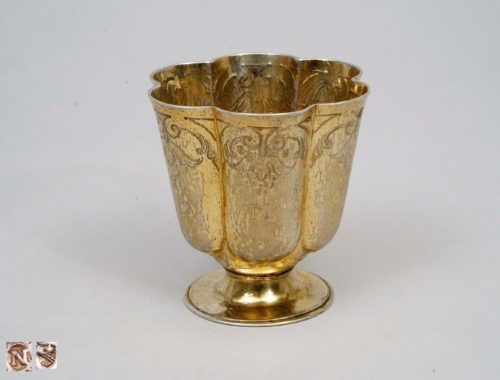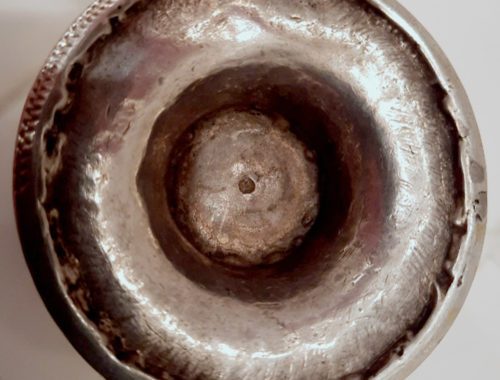Object number : 277
Marks: Nuremberg before 1629 (see R3, vol. 3, p. 41, BZ 3762; Tebbe et al., Vol. I, Part 1, p. 503, BZ 13)
Makers Mark:: Hans II Ulrich (see R3, MZ 3888 there still under Georg Ulrich); see Tebbe et al., Vol. I, Part 1, p. 632, MZ 0908)
Marks on lip edge, tremolier marks on the underside of the foot
Silver, embossed, hallmarked, gilded
Dimensions: height: 7.8 cm, weight: 85 g
Detailed Description
Detailed information
The timelessly elegant six-pass beaker from Nuremberg rises above a circular, smoothly polished base. The six-lobed wall of the cuppa is constricted towards the foot and widens conically towards the edge of the lip. The base and cuppa of the beaker are firmly connected. The transition from the foot to the bowl was softened by the goldsmith with elegantly curved spandrels, which, however, only catch the eye on closer inspection.
Below the edge of the lip, a particularly finely punched hanging ornament winds around the otherwise smoothly polished beaker as the only form of decoration. The filigree tendrils and tails occupies the upper third of the six protruding bulges of the wall. By repeating the fine tendrils hanging on each bulge, a circumferential ornamental frieze is created. The original fire-gilding completely covers all visible surfaces of the tumbler, only the base of the stand is left in silver.
Around 1600, ornamental engravings for vessel decorations were widespread and served goldsmiths as a model for engravings or punched ornamentation. A copper engraving such as that by Hieronymus Bang, Nuremberg 1592, may have served as a model for the decoration. Finely punched hanging tendrils were very popular in Nuremberg in the middle of the 17th century, especially for the “Römer” vessels, but they were generally less finely crafted than on the present beaker.
A number of cups from the first quarter of the seventeenth century have been preserved in Nuremberg: between 1609 and 1629, Christoph Jamnitzer and Franz Fischer created quatrefoil cups with biblical or mythological scenes.
In addition, between 1610 and 1640 in particular, trophies and chalices with a six-lobed cuppa have been preserved by goldsmiths such as Paulus Baier and Christoph Jamnitzer. There is a funnel and a columbine cup from 1609 by Hans Deinhard, both are decorated with engraved tendrils and tails below the rim of the lips. Another well-known six-pass beaker is the so-called “Sheaf Beaker/Garbenbecher” by Peter Wibers from 1603, the bulges of which form the tufts of a sheaf of corn.
Thanks to its clear shape and the stylishly used, finely embossed ornamentation, this mug can still be attributed to the late Renaissance. In terms of its fine punching technique, however, the beaker marks the beginning of a new form of decoration that became particularly popular around the middle of the 17th century.
Master:
Hans II Ulrich, son of the goldsmith Hans I Ulrich and Susanna, née Trost, married Anna in 1626, Georg I Rühl’s widow. Between 1626 and 1633 he worked as a goldsmith in Nuremberg. Due to his early death, only one other goldsmith’s work from the years 1626/29 is known: a ceremonial goblet reminiscent of a nautilus goblet with a large snail (silver, gold-plated), with a kneeling Indian with bow and arrow as a shaft figure, Neptune with a raised trident and Swan as the crowning figure as well as cupids and sea animals on the body. The finely crafted trophy is still in the council treasury of the Alsatian town of Ribeauvillé, in the “Trésor de la Mairie de Ribeauvillé”, France. The magnificent treasury piece is still the focus of the council treasury today. It was donated to the city by the Lords of Rappoltstein (Rabenstein/French Ribeaupierre), a noble family that ruled around Rappoltsweiler/Ribeauvillé between 1038 and 1673.
Literature:
Bott, Gerhard (ed.): Wenzel Jamnitzer and the Nuremberg goldsmith art 1500-1700, exhibit. GNM Nuremberg 1985, Munich 1985, p. 392f., cat. no. 441 (Hieronymus Bang, sheet 4 of a series of border decorations, copper engraving, Nuremberg around 1592)
Hörack, Christian: Grottesques, grimaces and dolphins, decorative elements in the Baroque, In: Söll-Tauchert, Sabine (ed.): Drinking more beautifully, Baroque silver from a Basel collection, exhibition in the Basel Historical Museum, Basel 2022, pp. 40 – 49 (on ornamental engravings, the spread of leaf, tendril and tail work in printmaking, esp. pp. 41-44)
Söll-Tauchert, Sabine (ed.): Drinking more beautifully, baroque silver from a Basel collection, exhibition in the Basel Historical Museum, Basel 2022, p. 234 cat. no. 128f., p. 235, cat. no. 130, p 236, Cat. No. 133, p. 237 Cat. No. 134f. (on Romans with punched tendril ornament), p. 279, cat. no. 175 (on the Akelei goblet by Hans Deinhard, Nuremberg 1609)
Tebbe, Karin, Timann, Ursula, Eser, Thomas and others: Nuremberg goldsmith art 1541 – 1868, Volume I, Masters, Works, Brands, Part 1: Text volume, Nuremberg 2007, p. 423, MZ 908, p. 632, MZ 906 ( on Ulrich Hans II), p. 503, BZ 13 (on the hallmark)
Tebbe, Karin, Timann, Ursula, Eser, Thomas and others: Nuremberg goldsmith art 1541 – 1868, volume I, part 2: panels, Nuremberg 2007, p. 717, fig.35, p. 877, no. 440, p. 878, No. 443, p. 931, no. 569, 570, p. 932, no. 571, p. 938, no. 593 (on Nuremberg cups with a multi-pass shape)
Tebbe, Karin: drinking and eating. Silver vessels for profane use, in: Nürnberger Goldschmiedekunst 2007, Vol. II, pp. 165-204
Tebbe, Karin and others: Nuremberg goldsmith art 1541-1868, volume II, gold gloss and silver beam, Nuremberg 2007, p. 182, fig. 155 (on the funnel cup by Hans Deinhard, 1609)
Marc Rosenberg: The Goldsmith’s Mark, Volume 3, Germany N-Z, Frankfurt/Main 1925, p. 41 (on the hallmark around 1600)
Online Resources:
https://www.guide-tourisme-france.com/VISITER/mairie-ribeauville–ribeauville-32006.htm




